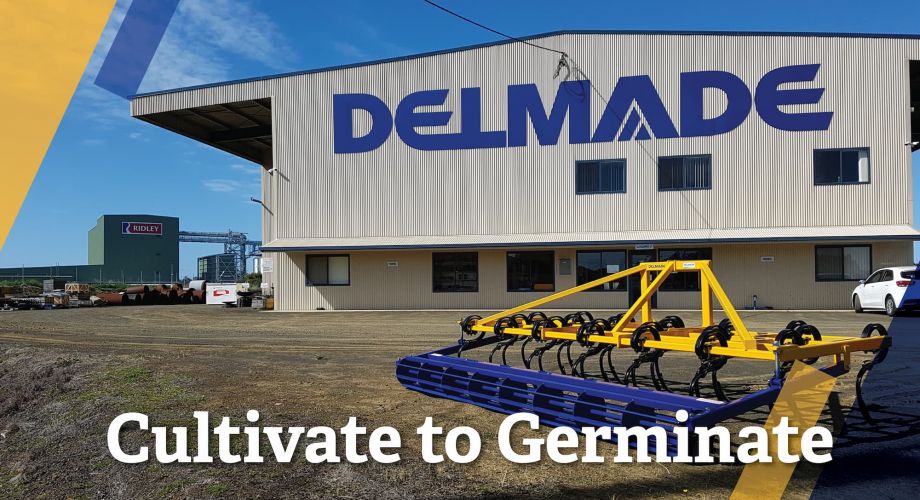Cultivate to Germinate
Jun 19, 2024 Posted by Brittany Cunningham

At Delmade we are about making sure every Farmer has options when it comes to our tillage range, from hobby farmers to multigenerational industry leaders there is something in our range to suit. A cultivator is something that’s affordable enough for hobby farmers or someone starting out, but effective enough that career and generational farmers still have a place for them in their tillage lineup so
If you are looking for a cost-effective way to increase the impact of your tillage practices, ensuring you get a fine seed bed preparation without having to do an excessive number of passes or use large amounts of diesel to achieve the result? or perhaps you are short on horsepower or have steep terrain and are looking for something that can still get the job done safely while still achieving the desired results. Then a cultivator may just be the implement for you.
What is a cultivator?
When you look up the meaning of the word Cultivate you get 2 outcomes.
- Prepare and use (land) for Crops
- To loosen or break up soil
And in a nutshell, that’s exactly why this implement has its name “Cultivator” because those 2 things are exactly what it is designed for. It is primarily used as a secondary tillage implement which means it's designed to come through after the muscle (primary tillage implement) has disturbed the soil and turned it over, causing the existing root bed to detach from the soil and moisture source killing the plant (if it was not already dead). Secondary Tillage is generally then used to refine the soil from a clump to finer particles often forming a seed bed.
What is a cultivator’s role in the tillage process?
Often after ploughing the ground is left cloddy with root mat still clumped to soil (insert soil clod pic) and in most cases that’s not a suitable finish for seeding as you will end up with uneven seed depth and dispersion as the seed either sits on top of or falls between the clumps. Generally, when preparing a seedbed for sowing it is important to make sure that the soil is refined to a point where the clods are removed as best possible so that once plants establish, they germinate consistently at an equal depth. Having a fine soil that is easily penetrable by roots and allows access to water and nutrients in the soil.
So it’s role is to come through and break up any of the clods once ploughed the clumps of soil dry out and loosen up, if you choose to use a cultivator the configuration of the tines creates a rake like comb that moves through the soil to assist in shattering the clumps of soil. This has a positive impact on the seed bed in the sense that the soil particles are smaller allowing for better and more consistent seed soil contact giving you a better strike within your crop.
Cultivator Design – and why it’s designed this way
The design of the cultivator assists with the effectiveness of the breakdown of these clods, most units will have a tine spacing of somewhere around 120-150mm meaning that large clumps are collected and broken down effectively with minimal power usage. Most units are equipped with the extra failsafe of an additional clod breaker in the form of a crumble roller. These are a multi-use and multi-benefit tool as they cover the entire span of the tines running horizontally behind them and usually consist of angle iron welded cylindrically around the unit, as the roller rolls over the soil it spins to break down clumps as it rolls over them. Another benefit of a crumble roller is that it assists with depth control, of the tines, smaller units generally have a ratchet height adjustment, and larger ones are hydraulically adjusted but the depth you set the roller to will hold your tines from digging deeper into the soil.
Finish
Be it with the cultivator or the crumble roller the finish left behind by the unit is ideal, by leaving a slight ridge in the soil it assists in reducing water and wind erosion pre-seed emergence or whilst the soil is left fallow by creating peaks it also provides a form of seed bed for uniform rows. A lot of farmers choose to mount either gravity or pneumatic seeder boxes on their cultivators so that the seed can be dropped behind the tines and covered by the crumbler the limit with these units really is where your imagination and design skills take it.
On top of all of the agronomic benefits of having a cultivator, you can add to it the fact that they are a cost effective option, relatively simple in construction and low maintenance the humble cultivator punches well above its weight with minimal outlay or ongoing cost, and with a couple of passes you can achieve a finished seed bed you may expect to see from a power implement.
If you are interested in finding out more about the build and workings of cultivators, or the uses and benefits from your farm feel free to give Delmade a call today for pricing and availability.

